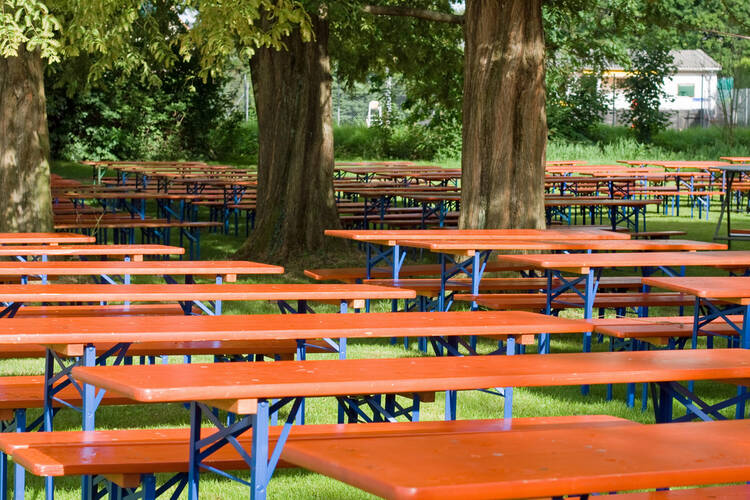
Apart from your menu and offerings, one of the key elements that can consistently attract customers to your beer garden is its design, specifically the layout and floor plan.
A well-designed beer garden creates an inviting atmosphere that encourages guests to relax, socialize, and stay longer, ultimately increasing their spending.
It also improves service efficiency, customer flow, and overall guest experience, all of which contribute to higher customer retention and positive word-of-mouth.
The truth is that your beer garden’s design can set you apart from competitors.
Whether you are planning to improve an existing space or start a new beer garden business, thoughtful design matters.
In this article, we will explore creative and functional beer garden design ideas, including layout and floor plan suggestions that optimize space, comfort, and visual appeal.
Beer Garden Design Ideas with Layout and Floor Plan
-
Central Communal Table Layout
Designing your beer garden with long communal tables placed in the center encourages a lively, social atmosphere where guests can easily interact and make new connections.
These tables foster a sense of community by bringing larger groups and strangers together in a shared space.
To accommodate different preferences, smaller tables or benches can be positioned around the perimeter, offering more private or intimate seating options.
This balanced layout optimizes space usage by combining open, social areas with quieter corners.
In addition, the central communal tables make it easier for staff to serve multiple guests efficiently.
-
U-Shaped Garden with Central Fire Pit
Creating a U-shaped seating layout around a centrally placed fire pit or water feature offers both warmth and visual appeal, making your beer garden inviting and comfortable.
This arrangement naturally encourages social interaction, as guests face each other, fostering lively conversations and group bonding.
The open center maintains a cozy yet spacious atmosphere, preventing overcrowding while creating a welcoming environment.
During cooler evenings, the fire pit adds warmth and ambiance, extending outdoor usability into colder months.
-
Pergola-Covered Zones
Installing pergolas or trellises over various seating zones provides both functional shade and aesthetic appeal to your beer garden.
Draping these structures with climbing greenery, twinkling string lights, or flowing outdoor curtains adds a touch of charm and creates inviting, cozy spaces.
By designating each pergola for specific uses such as dining, lounging, or game areas, you offer guests diverse experiences while giving clear structures to your layout.
These shaded zones protect visitors from the sun and light rain, encouraging longer stays.
Overall, pergolas enhance comfort, atmosphere, and versatility, making your beer garden more attractive and enjoyable year-round.
-
Raised Deck and Tiered Seating
Introducing a raised wooden deck or tiered seating adds dimension and structure to your beer garden, effectively defining distinct zones within the space.
The elevated deck can be reserved for VIP guests or used as a stage for live performances, creating a focal point that draws attention and adds excitement.
Meanwhile, the lower tiers provide comfortable general seating with clear sightlines to the main attractions.
This vertical zoning improves crowd management by separating different guest groups, reducing congestion, and enhancing overall flow.
-
Garden Courtyard Style
Surrounding your beer garden with lush greenery such as hedges, trees, and potted plants creates a peaceful courtyard atmosphere that invites relaxation and socializing.
Seating arranged in small clusters around the garden encourages intimate conversations while winding pathways connect each area, guiding guests through the space naturally.
This design fosters a sense of privacy and tranquility, making it especially appealing for families and those seeking a more upscale, refined experience.
The natural elements not only enhance aesthetics but also provide shade and improved air quality.
This serene layout encourages guests to linger, enjoy their surroundings, and return for a calming, leisurely visit.
-
Bar-Centric Circular Layout
Designing your beer garden around a centrally located circular bar creates a dynamic and efficient layout that enhances both customer experience and staff workflow.
Tables and benches radiate outward from the bar, ensuring that guests have easy access to drinks while maintaining clear lines of sight.
This centralized design reduces congestion, improves service speed, and encourages social interaction among patrons.
It also allows bartenders to serve in all directions, maximizing efficiency during peak hours.
The vibrant atmosphere created at the heart of the beer garden becomes a focal point that draws attention, increases drink sales, and keeps energy levels high.
-
Picnic-Style Layout with Lawn Games
Opting for picnic tables arranged on grassy turf creates a casual, laid-back setting that encourages guests to linger and enjoy their time.
This layout is perfect for families, groups of friends, and weekend visitors seeking a fun, informal experience.
Designate open spaces for lawn games like cornhole, bocce ball, or giant Jenga to boost engagement and entertainment value.
Marked walkways between tables and activity zones ensure smooth customer flow and staff efficiency.
Adding string lights, umbrellas, or shaded canopies enhances comfort during hot or sunny days.
-
Shipping Container Design
Using modified shipping containers for your beer garden’s bar, kitchen, or storage areas offers a creative and cost-effective design solution.
These containers provide a sturdy, weather-resistant structure that can be customized with windows, service counters, and branding elements.
Arranging seating around the container promotes a central gathering space, while retractable awnings or pergolas offer shade and protection from the elements.
The industrial, modern aesthetic appeals to younger, trend-conscious customers and works particularly well in urban environments.
This setup is also semi-mobile, making it ideal for pop-up beer gardens or seasonal installations.
-
Covered Alley Beer Garden
If you are working with a narrow or constrained space, an alley-style beer garden layout can be both practical and charming.
This design features a central walkway with bar stools and two-person tables arranged along both sides, maximizing limited square footage without feeling overcrowded.
Overhead string lights add warmth and ambiance, while vertical wall planters introduce greenery without using valuable floor space.
This setup creates an intimate, tucked-away atmosphere perfect for romantic evenings or quiet gatherings.
It’s especially effective in urban areas or downtown settings where space is at a premium.
With thoughtful styling, small beer gardens can still feel inviting and profitable.
-
Indoor-Outdoor Hybrid Plan
Combining indoor seating with a seamless transition to an outdoor beer garden creates a versatile, year-round experience that maximizes space and revenue.
This design uses retractable glass walls, folding doors, or large sliding panels to blur the line between indoor comfort and outdoor charm.
During warmer months, the space opens fully to allow natural airflow and an open-air feel, while in colder seasons, the interior remains warm and inviting without sacrificing views or ambiance.
Matching interior and exterior design elements such as flooring, furniture, lighting, and décor creates a cohesive aesthetic.
